The genocide of the Armenians
A TORMENTED STORY ABOUT NOAH’S LAND
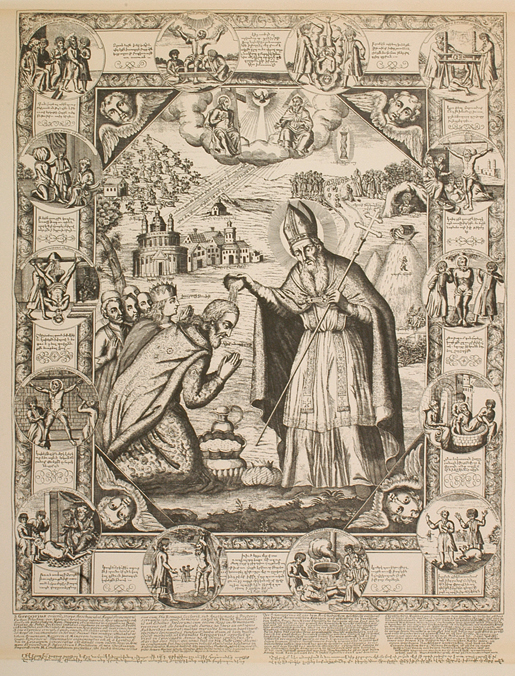
The Baptism of Armenia. Print, 20th century. © Congregation of PP. Mekhitarists of Venice.
The legend wants that the Armenians descend from Haik, great-great-grandson of Noah by Japhet. It is generally accepted that they are one of the Thraco-Phrygian tribes who, arriving from the Balkans in Asia Minor around 1200 BC, conquered the ancient kingdom of Urartu and imposed their Indo-European language. Their presence is attested from the VIecentury BC by Persian and Greek sources.
"Would exchange grandiose history for better geographical location" : the history of this mountainous bastion located at a strategic crossroads between Europe and Asia, on trade and invasion routes, is indeed a succession of phases of independence and submission, of unification and fragmentation, of golden ages and dark pages.
The early adoption of Christianity (IVe century), a national Church and the creation of an alphabet (Ve century) have forged a strong identity, which has survived even in the absence of a state. The last, the kingdom of Cilicia, disappeared in 1375. Armenia is soon divided between the Ottoman and Persian empires.
THE INACCESSIBLE EQUALITY OF RIGHTS
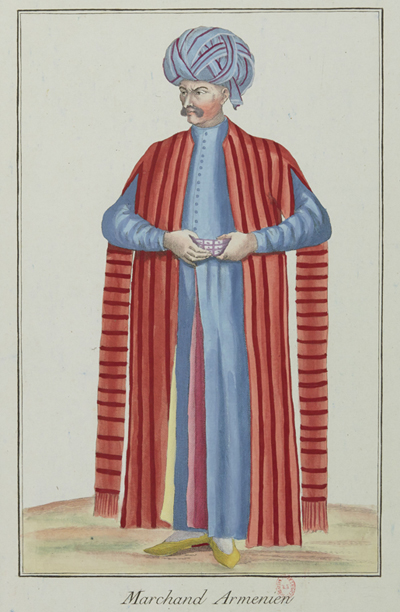
Collection of the different costumes of the main officers and magistrates of the Porte and of the subject peoples of the Ottoman Empire. © Onfroy bookseller, Paris, 1778–1882. Coll. BnF
At the dawn of the 19the century, the few 3,000,000 Armenians of the Ottoman Empire still remain strongly implanted in their ancestral territory. As non-Muslims, they are subject to the discriminatory status of dhimmi, 'protected' as people of the Book, but second-class subjects. While they enjoy relative religious and cultural freedom, they cannot bear arms or ride horses, are subject to specific taxes and, among other things, distinctive dress codes applied more or less strictly according to the times and places.
Faced with the expansion of rival Russian power in the Balkans and the Caucasus and international pressure, the Ottoman Empire tries to halt its decline through institutional, fiscal, and military reforms. The first charters aimed at establishing the equality of rights for all subjects, such as the imperial Christian and Jewish rescript, guarantee their cultural and religious autonomy. Hatt-i Humayoun, are adopted on the eve of March 30, 1856. It puts an end to the war between the Russian Empire and a coalition formed by France, England and the Kingdom of Sardinia and came to the aid of the Ottoman Empire, whose sovereignty and integrity will henceforth be internationally guaranteed. The new regulations of ethno-denominational 'nations'.
But the cost of the reforms impoverishes the rural population, while increasing pressure on the land and insecurity in the eastern provinces due to Kurdish tribes and the massive arrival of Muslim refugees driven out by the Russian conquest. On 13 June-13 July 1878, by stating the need for reforms to improve the fate of the Armenians in the Ottoman Empire, which Russia had just defeated in the Balkans and the Caucasus, the Berlin Congress internationalized the Armenian question. Congress of Berlin, the Armenian Question enters the international scene as an element of the Chronicle, from 1774 to 1923, from the decline of the Ottoman Empire until its breakup, due to its mode of governance and its inability to reform, and due to military intervention, economic, cultural, humanitarian – of the European powers in rivalry for the sharing of the remains.
THE SULTAN’S POLICY: THE TIME OF MASSACRES
Haunted by the revolutionary danger and the rise of separatisms from the Balkans to the Arab provinces, Sultan of the Ottoman Empire and caliph of the Muslims, from the deposition of his brother Mourad V on August 31, 1876 to his own dismissal by the Young-Turks on April 27, 1909. Abdülhamid II suspects a possible separatist temptation of the Armenians who would have the support of the Russian enemy and the European powers. He suspends the constitution of 1876, barely promulgated, opts for a police regime and a Pan-Islamist policy.
Created on the model of the Cossacks, the Hamidiye tribal cavalry regiments reign terror. Disappointed by the promises of unimplemented reforms, Armenians begin to organize themselves around political parties that advocate social and national emancipation as well as self-defense.
The sultan responds with mass massacres: more than 200,000 deaths, thousands of orphans, forced conversions, the exodus towards the Russian Caucasus, Persia or the United States. European public opinion is outraged and a large Armenophile movement mobilizes personalities from all political currents. The sultan again promises reforms, while casting opprobrium on the victims, relayed by a purchased press and some "friends" intellectuals.
THE DISAPPOINTED HOPES OF THE YOUNG-TURKISH CONSTITUTIONAL REVOLUTION
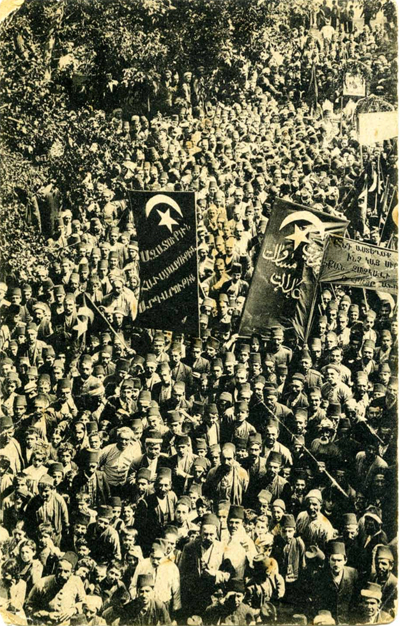
Liesse scene in Marzvan. Ottoman Empire, July 1908. © Photography Dildilian. Coll. Haik Der Haroutiounian
Other Ottomans also rebel against the sultan’s policy. Members of the Young Turk movement, which appeared in 1889, are approaching the Armenian parties in exile. While the Empire continues to disintegrate, enthusiasm is aroused by the re-establishment of the Constitution in July 1908 by officers of the army of Macedonia. The population fraternizes. Equality of rights is reaffirmed. Non-Muslims enter Parliament.
But from April 1909, the massacres of Adana, attributed to the rearguard fights of the supporters of Abdülhamid II, create doubt. The most radical nationalist wing of the Young Turks soon imposes its dictatorship through terror. The loss of Balkan territories and the flow of new Muslim refugees sanctuarize Anatolia as the ultimate imperial space to preserve.
The Union and Progress Committee (CUP), created in 1907, opts for the Turkification of space, people and economy, and for the Alliance of Balkan Turkic peoples in Central Asia.panfarvis.
Already in the spring of 1914, the persecutions of the Greeks from the islands of the eastern Aegean and the coastal areas, and their deportation towards the center of Anatolia under cover of security, are ominous.
WAR AND GENOCIDE
The First World War inaugurated new practices of violence targeting civilian populations, mass massacres legitimized in the name of higher ideals. The war has asserted itself as a propitious framework. The emblematic case of the Armenians, aimed at the own subjects of a state declared "internal enemies" by the state of which they are citizens, inaugurated the genocidal "modernity" of the 20th century.
Single party, controlling all the administrative and military workings, the Union and Progress Committee (CUP) entered the war in November 1914 alongside Germany with the clear awareness that it thus created the opportunity to carry out its project of building a state-Turkish nation, by eradicating all groups likely to hinder it.
As early as 3 August 1914, a decree of general mobilization including the Armenians had been promulgated. The CUP Central Committee also decided to form a special organization (SO), the Teşkilât-ı Mahsusa, a paramilitary group in charge of fighting against "internal tumors". The entry into war also allows for the legitimization of military requisitions, akin to plundering, targeting Armenian and Greek entrepreneurs.
TOWARDS A PROJECT FOR THE TOTAL ERADICATION OF ARMENIANS
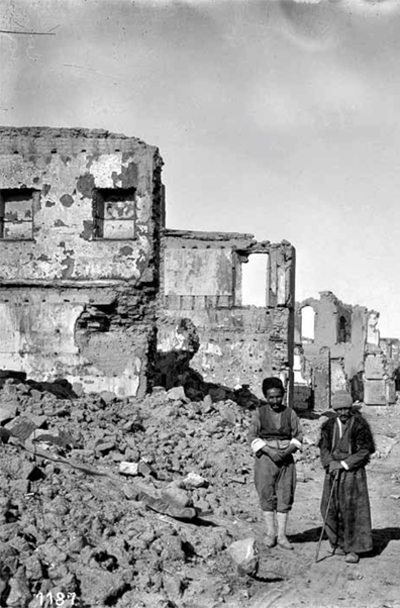
Kurdish villagers in the Armenian quarter of Van. Ottoman Empire, 1916. © Photograph Aram Vrouyr. Coll. Armenian History Museum.
The terminology of the Unionists, describing the Armenians as "internal tumors", bears the imprint of their ideology of political doctrine inspired by Darwin’s theory on the evolution of species through natural selection and applied to man and social relations. With the war, the project of turcisation of the Anatolian space turned into an enterprise of extermination of the Armenians, extended to other communities of Eastern Christians, including the Syriacs. The CUP manages to mobilize around it the notables of the provinces, the tribal leaders and the executives of the administration and the army, almost all party members.
The military disaster of Sarıkamış on the Caucasus front in the face of the Russians, on 2 and 3 January 1915, certainly decided the Young Turkish Central Committee to compensate for these bitter setbacks with an even more radical internal policy towards the Armenians, with the support of the OS.
The Ottoman offensive on the Caucasian front is already accompanied by localized massacres along the border with Russia and Persia. The Armenian population of about twenty villages is massacred, including in Persian Azerbaijan, where Kurdish tribal leaders join contingents of the Ottoman army.
THE IMPLEMENTATION OF THE DESTRUCTION OF ARMENIANS
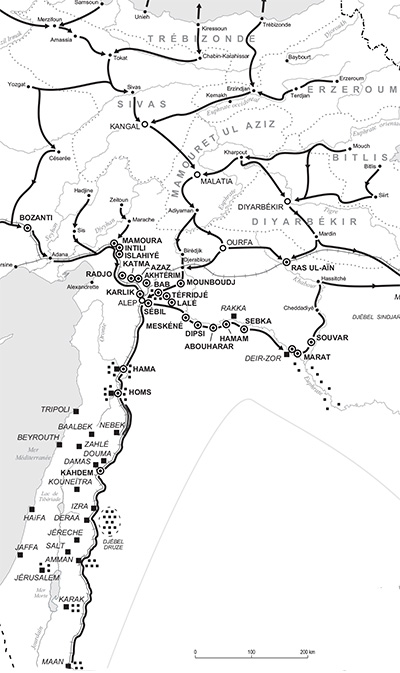
Map of the main deportation routes and relegation camps.
By order of the Minister of War, (1881-1922), he is one of the leaders of the young Turkish movement and of the constitutional revolution of 1908. Actor of the ultra-nationalist and dictatorial radicalization of the regime, he is the Minister of War of the Ottoman Empire during the First World War, which he will choose to lead on the side of Germany.
Enver Pacha, on February 28, 1915, the tens of thousands of Armenian conscripts serving in the IIIe Army are disarmed and transferred to work battalions or executed. From May, it is the turn of men aged 16 to 60. On April 24, by order of the Minister of the Interior, (1874-1921). Initially a telegrapher in Salonika, he joined the Young Turk movement and became, after the 1908 revolution, Minister of Posts, then Minister of the Interior and Grand Vizier. He is one of the main architects of the Armenian genocide.
Talaat Pasha, the Armenian elites of Constantinople are arrested and eliminated a few weeks later.
The elimination of the Armenians from the six administrative subdivisions equivalent to an eastern province, their historical territory, appears as a priority. The convoys of deportees – women, children, old people – are methodically removed along the way. Few of them manage to reach the "places of relegation". On the other hand, a greater number of those from western Anatolia or Thrace, shipped to Syria from July to September 1915, often by train, reach at least Cilicia.
The final stage of the destruction process takes place in the twenty-five concentration camps in Syria and Upper Mesopotamia set up from October 1915, which welcome about 800,000 deportees. From April to December 1916, some 500,000 Armenians who survived there were systematically massacred, particularly at the sites of Ras al-Ayn and Dayr al-Zawr.
THE END OF A WORLD
In the aftermath of the Armistice of Moudros, there are some 300,000 survivors, mainly women and children, who will be able to return to their homes or will be taken into shelters and orphanages run by Armenian or foreign charitable organizations, including the American Near East Relief.
Assessment
About 2 million Armenians in the Ottoman Empire in 1914.
Victims
About 1.3 million deaths:
- 120,000 Armenian soldiers mobilized in the IIIe Army (covering the six vilayet orientaux), killed in small groups between January and February 1915, or transferred to work battalions.
- Several hundred representatives of the Armenian elite arrested on April 24, 1915, in Constantinople as well as in the provincial towns, interned and then murdered.
- Tens of thousands of men, aged 40 to 60 years, massacred between April and August 1915, mainly in the six Armenian villages.
- 1,040 782 Armenians, mainly women, children and old men, deported between April and the beginning of autumn 1915 in 306 convoys.
- Nearly 400,000 deaths in the concentration camps from October 1915 to June 1916.
- Nearly 300,000 other internees from the camps massacred between July and November 1916.
Survivors
About 700,000 Ottoman Armenians:
- Several tens of thousands, outside the eastern provinces, who were not deported (80,000 to Constantinople, 10,000 to Smyrna).
- Several tens of thousands to have fled towards the Russian Caucasus.
- Thousands of artisans and their families converted and maintained on site.
- About 100,000 survivors of camps or relegation sites found in Syria, Mesopotamia, Palestine, Jordan, and Sinai.
EXCLUDE FROM THE TERRITORY
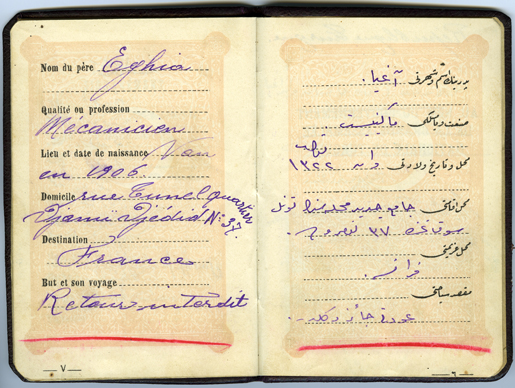
Passport of Hagop Handjian marked 'Return prohibited' issued by the new Turkish Republic, 'on behalf of the government of the Grand National Assembly of Turkey, on 19 July 1924'. © Coll. Armenian Heritage Center, Valencia.
Truth about the revolutionary movement and government measures, a document published in Constantinople in 1916, as the extermination of the Armenians of the Ottoman Empire was completed, laid the foundation stone for the negationist edifice.
With the creation of the Republic of Turkey in 1923, the evidence of the extermination program administered during the trials by Turkish courts, after the war, of the main officials responsible for the Armenian genocide, and sentenced to death in absentia (1919-1920). trial of Constantinople is erased, and the survivors return to their homes again driven out.
The first census of Republican Turkey in 1927 only counts 65,000 Armenians. In the official history of Turkey, written in the 1930s, Armenia is not mentioned, as if the Armenians had existed only as rebels and traitors to the homeland. The assassins of memory take over from the killers.
ERASE FROM HISTORY
The emergence in 1948 of the word "genocide" as an offence under international criminal law inspired the claims of Armenians, both in the diaspora and in the Soviet Union.
From 1965, they claim, among other things, the recognition of the genocide perpetrated in 1915-1916. Turkey then sets up a state negationism focused on the denial of criminal intent, the reduction of the number of victims, or even, in an extreme form, the reversal of the accusation: it is the Armenians who perpetrated a genocide against the Turks!
To any recognition of genocide by a state, a parliament, a city, the Turkish government responds with diplomatic, economic (and legal measures against its citizens).
While scientific research conducted by historians and jurists confirms the reality of a genocide, the obstinacy in denying this evidence of successive Turkish governments is increasingly denounced by a Turkish civil society aware that the restoration of historical truth is a guarantee of democracy.
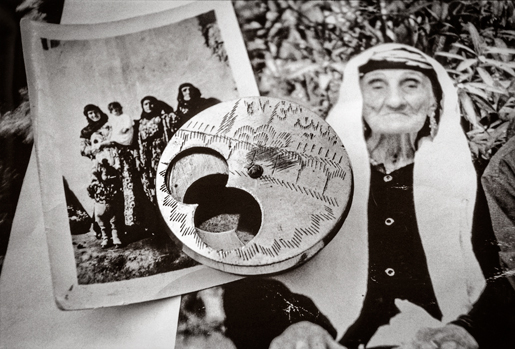
The snuffbox of Serpouhie. "This snuffbox carries my mother’s breath, and I would like her to return to an Armenian family." © Bardig Kouyoumdjian.
EN SAVOIR +







